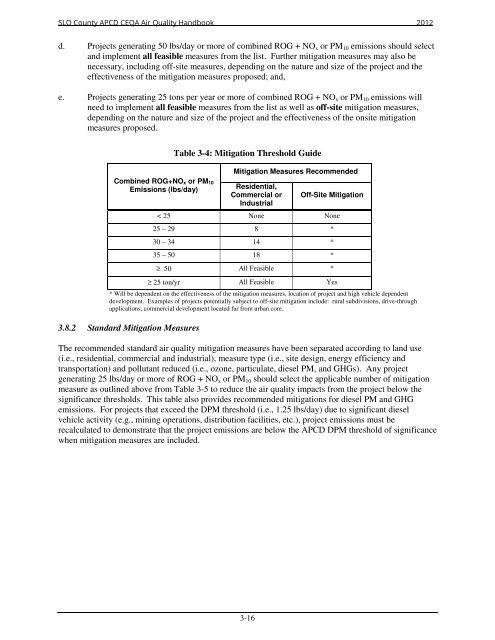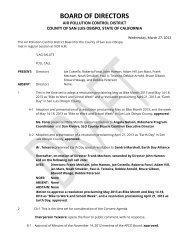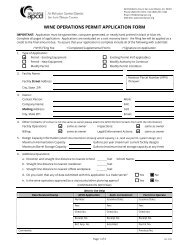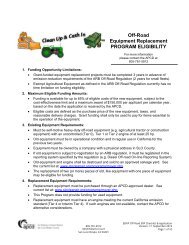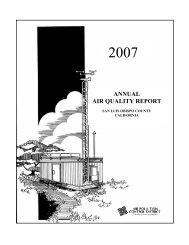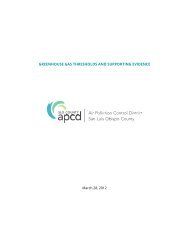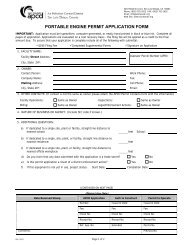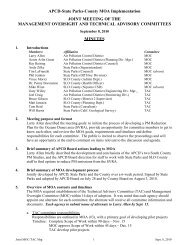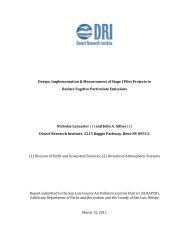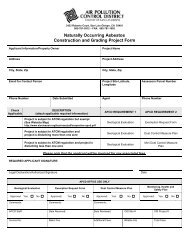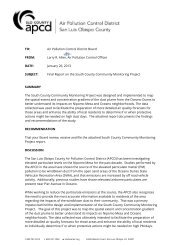CEQA Air Quality Handbook - Air Pollution Control District
CEQA Air Quality Handbook - Air Pollution Control District
CEQA Air Quality Handbook - Air Pollution Control District
You also want an ePaper? Increase the reach of your titles
YUMPU automatically turns print PDFs into web optimized ePapers that Google loves.
SLO County APCD <strong>CEQA</strong> <strong>Air</strong> <strong>Quality</strong> <strong>Handbook</strong> 2012<br />
d. Projects generating 50 lbs/day or more of combined ROG + NO x or PM 10 emissions should select<br />
and implement all feasible measures from the list. Further mitigation measures may also be<br />
necessary, including off-site measures, depending on the nature and size of the project and the<br />
effectiveness of the mitigation measures proposed; and,<br />
e. Projects generating 25 tons per year or more of combined ROG + NO x or PM 10 emissions will<br />
need to implement all feasible measures from the list as well as off-site mitigation measures,<br />
depending on the nature and size of the project and the effectiveness of the onsite mitigation<br />
measures proposed.<br />
Combined ROG+NO x or PM 10<br />
Emissions (lbs/day)<br />
Table 3-4: Mitigation Threshold Guide<br />
Mitigation Measures Recommended<br />
Residential,<br />
Commercial or<br />
Industrial<br />
Off-Site Mitigation<br />
< 25 None None<br />
25 – 29 8 *<br />
30 – 34 14 *<br />
35 – 50 18 *<br />
≥ 50 All Feasible *<br />
≥ 25 ton/yr All Feasible Yes<br />
* Will be dependent on the effectiveness of the mitigation measures, location of project and high vehicle dependent<br />
development. Examples of projects potentially subject to off-site mitigation include: rural subdivisions, drive-through<br />
applications, commercial development located far from urban core.<br />
3.8.2 Standard Mitigation Measures<br />
The recommended standard air quality mitigation measures have been separated according to land use<br />
(i.e., residential, commercial and industrial), measure type (i.e., site design, energy efficiency and<br />
transportation) and pollutant reduced (i.e., ozone, particulate, diesel PM, and GHGs). Any project<br />
generating 25 lbs/day or more of ROG + NO x or PM 10 should select the applicable number of mitigation<br />
measure as outlined above from Table 3-5 to reduce the air quality impacts from the project below the<br />
significance thresholds. This table also provides recommended mitigations for diesel PM and GHG<br />
emissions. For projects that exceed the DPM threshold (i.e., 1.25 lbs/day) due to significant diesel<br />
vehicle activity (e.g., mining operations, distribution facilities, etc.), project emissions must be<br />
recalculated to demonstrate that the project emissions are below the APCD DPM threshold of significance<br />
when mitigation measures are included.<br />
3-16


